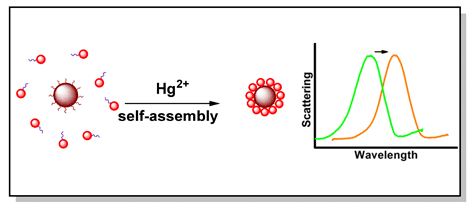| [1] Li, Y.; Jing, C.; Zhang, L.; Long, Y. T. Chem. Soc. Rev. 2012, 41, 632.
[2] Anker, J. N.; Hall, W. P.; Lyandres, O.; Shah, N. C.; Zhao, J.; Van Duyne, R. P. Nature Mater. 2008, 7, 442.
[3] Zhang, L.; Sheng, J. J.; Fan, Q. L.; Wang, L. H.; Huang, W. Chin. Sci. Bull. 2014, 59, 169(in Chinese). (张磊, 沈晶晶, 范曲立, 汪联辉, 黄维, 科学通报, 2014, 59, 169.)
[4] Wang, Y. J.; Zu, X. H.; Yi, G. B.; Luo, H. S.; Huang, H. L.; Song, X. L. Chin. J. Chem. 2016, 34, 1321.
[5] Li, Y.; Lin, Z.; Li, R. Z.; Liu, X. Acta Chim. Sinica 2012, 70, 1304(in Chinese). (李迎, 林钊, 李蓉卓, 刘霞, 化学学报, 2012, 70, 1304.)
[6] Kelly, K. L.; Coronado, E.; Zhao, L. L.; Schatz, G. C. J. Phys. Chem. B 2003, 107, 668.
[7] Hartland, G. V. Chem. Rev. 2011, 111, 3858.
[8] Sonnichsen, C.; Reinhard, B. M.; Liphardt, J.; Alivistos A. P. Nat. Biotechnol. 2005, 23, 741.
[9] Sheikholeslami, S.; Jun, Y.; Jain, P. K.; Alivistos, A. P. Nano Lett. 2010, 10, 2655.
[10] Jun, Y.-W.; Sheikholeslami, S.; Hostetter, D. R.; Tajon, C.; Craik, C. S.; Alivistos A. P. Proc. Natl. Acad. Sci. U. S. A. 2009, 106, 17735.
[11] Reinhard, B. M.; Sheikholeslami, S.; Mastroianni, A.; Alivistos, A. P.; Liphardt, J. Proc. Natl. Acad. Sci. U. S. A. 2007, 104, 2667.
[12] Zhen, S. J.; Wan, X. Y.; Zheng, L. L.; Li, C. M.; Huang, C. Z. Sci. Bull. 2016, 61, 639.
[13] Li, X.-L.; Zhang, Z.-L.; Zhao, W.; Xia, X.-H; Xu, J.-J.; Chen, H.-Y. Chem. Sci. 2016, 7, 3256.
[14] Lermusiaux, L.; Maillard, V.; Bidault, S. ACS Nano 2015, 9, 978.
[15] Yoon, J. H.; Lim, J.; Yoon, S. ACS Nano 2012, 6, 7199.
[16] Qian, G. S.; Kang, B.; Zhang, Z. L.; Li, X. L.; Zhao, W.; Xu, J. J.; Chen, H. Y. Chem. Commun. 2016, 52, 11052.
[17] Clarkson, T. W.; Magos, L.; Myers, G. J. N. Engl. J. Med. 2003, 349, 1731.
[18] Ma, X.; Song, F.; Wang, L.; Cheng, Y.; Zhu, C. J. Polym. Sci. Polym. Chem. 2012, 50, 517.
[19] Nolan, E. M.; Lippard, S. J. Chem. Rev. 2008, 108, 3443.
[20] Yang, Y. M.; Zhao, Q.; Feng, W.; Li, F. Y. Chem. Rev. 2013, 113, 192.
[21] Zhao, Q.; Li, F. M.; Huang, C. H. Chem. Soc. Rev. 2010, 39, 3007.
[22] Quang, D. T.; Kim, J. S.; Yong, J. Chem. Soc. Rev. 2010, 110, 6280.
[23] Kim, H. N.; Ren, W. X.; Kim, J. S.; Yong, J. Chem. Soc. Rev. 2012, 41, 3210.
[24] Zhang, Y.; Li, W.; Wang, Q.; Zhang, R. X.; Xiong, Q. J.; Shen, X.; Guo, J.; Chen, X. M. Acta Chim. Sinica 2013, 71, 1496(in Chinese). (张勇, 李伟, 王强, 张若璇, 熊启杰, 沈祥, 郭靖, 陈雪梅, 化学学报, 2013, 71, 1496.)
[25] Zhang, C. Y.; Meng, Y. Z.; Kuang, J. Z.; Xu, L. Acta Chim. Sinica 2015, 73, 409(in Chinese). (张冲洋, 孟玉珠, 匡金志, 徐岚, 化学学报, 2015, 73, 409.)
[26] Wang, Q.; Yang, X. H.; Yang, X. H.; Liu, P.; Wang, K. M.; Huang, J.; Liu, J. B.; Song, C. X.; Wang, J. J. Spectrochim. Acta, Part A 2015, 136, 283.
[27] Liu, C. W.; Hsieh, Y. T.; Huang, C. C.; Lin, Z. H.; Chang, H. T. Chem. Commun. 2008, 19, 2242.
[28] Li, L.; Li, B. X.; Qi, Y. Y.; Jin, Y. Anal. Bioanal. Chem. 2009, 393, 2051.
[29] Guan, H. N.; Liu, X. F.; Wang, W.; Liang, J. Z. Spectrochim. Acta Part A 2014, 121, 527.
[30] Hung, Y. L.; Hsiung, T. M.; Chen, Y. Y.; Huang, Y. F.; Huang, C. C. J. Phys. Chem. C 2010, 114, 16329.
[31] Si, S.; Kotal, A.; Mandal, T. K. J. Phys. Chem. C 2007, 111, 1248.
[32] Ni, W. H.; Chen, H. J.; Su, J.; Sun, Z. H.; Wang, J. F.; Wu, H. K. J. Am. Chem. Soc. 2010, 132, 4806.
[33] Liu, D. B.; Qu, W. S.; Chen, W. W.; Zhang, W.; Wang, Z.; Jiang, X. Y. Anal. Chem. 2010, 82, 9606.
[34] Zhang, T. T.; Li, H.; Hou, S. W.; Dong, Y. Q.; Pang, G. S.; Zhang, Y. W. ACS Appl. Mater. Interfaces 2015, 7, 27131.
[35] Li, K.; Wang, K.; Qin, W. W.; Deng, S. H.; Li, D.; Shi, J. Y.; Huang, Q.; Fan, C. H. J. Am. Chem. Soc. 2015, 137, 4292. |
